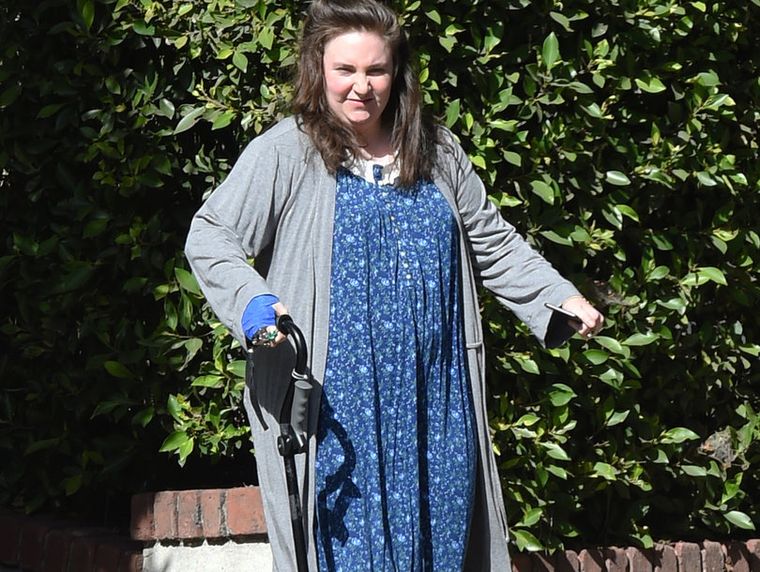On November 1, 2019, Lena Dunham, American actor, writer and producer whose hit show Girls won her a legion of fans, took to Instagram to announce that she had Ehlers-Danlos syndrome (EDS)—a group of disorders affecting the joints and skin. “I could lie and say it was an early Halloween look…. But the truth is just: this is what life is like when I am struggling most with a chronic illness. An Ehlers-Danlos syndrome flare means that I need support from more than just my friends… so thank you, sweet cane,” she posted in response to a paparazzi photo that captured her walking with a cane. Before Dunham, two more public figures had shared on social media about living with EDS. In October 2019, Australian singer-songwriter Sia Furler, who often wears a dramatic wig to obscure her face and protect her privacy, tweeted, “I am suffering with chronic pain, a neurological disease, Ehlers Danlos and I just wanted to say to those of you suffering from pain, whether physical or emotional, I love you, keep going. Life is f**king hard. Pain is demoralizing, and you're not alone.” In June 2019, The Good Place actor and body positivity campaigner Jameela Jamil posted on Instagram about her experience with EDS. “Every time I cut, I scar,” she wrote.
EDS weakens the connective tissues of the body, making the joints loose and the skin thin, stretchy and vulnerable to bruises. Depending on the level of severity, it can also weaken blood vessels and organs. Although there is no cure for it as yet, experts believe that the symptoms can often be treated and managed well.
“This is an inherited connective tissue disorder, which is either passed on from generation to generation or caused by the abnormal mutation of a gene,” says Dr Paresh Pai, vascular surgeon, Bhatia Hospital, Mumbai. “Connective tissue is found everywhere in the body, including in the nervous system as it is the one which connects every other tissue and organ of the body.” The most common form of connective tissue, he says, is collagen and any weakness in the collagen results in hypermobile (extremely flexible) joints, which means there is a high tendency of damage to joints. “This can happen in any organ of the body,” says Pai. “Take, for example, the heart. When there is no support of the connective tissue, there is a tendency of the artery to damage and rupture. Likewise the uterus, too, can rupture towards the third trimester as the baby grows and the skin stretches.” To further explain it, he cites the example of his 18-year-old patient. “He was playing volleyball and that was enough to cause the rupture of his brachial artery, which is the major blood vessel of the upper arm,” says Pai. “He was immediately hospitalised for the reparation of the artery. The patient will always be prone to it. It can recur. These patients must be extra careful to keep themselves safe at all times.”
According to the National Organization for Rare Disorders, which further classifies the disease into thirteen sub-divisions, symptoms of EDS may become apparent in childhood. However, depending upon the form and severity, the age of diagnosis varies widely. Reported estimates of the incidence of all EDS types range from 1 per 2,500 to 1 per 5,000 births.
Mumbai resident Radhika Sharma, a mother of two children aged 10 and 15, has been living with EDS for five years now. Every morning, she must take her daily dose of Pantacid 40 to beat acidity or she feels “dizzy, nauseous and giddy”. In addition, she experiences extreme hair fall, dry eyes and a dry mouth. Her knees give her trouble, hips ache every now and then, and she suffers from vertigo, severe constipation and intestinal issues. “EDS symptoms in my case are more internal than external,” she says. “I do not look like a patient. In fact, until my second delivery, I had no medical issues at all. And then they all came together.” Sharma used to be an active girl in school and college. “I did have loose joints and I did dislocate my right hand a few times while playing, but it did not seem to be a cause for concern at the time,” says the homemaker who got married at 25 and delivered her second child at 31. She suffers from severely low blood pressure (her normal range is 70/95, far lower than the normal level—90/120). Sharma is now on medication (Gabapentin 400) for tackling the incessant twitching on the left side of her face. It works as a muscle relaxer. “My neurologist told me that this is common among those suffering from EDS as our nervous system is weak,” she says.
Sharma suffers from EDS Type 3 or Hypermobile EDS, which means that in a yoga class she would stand out for above par flexibility. But it also means that she is prone to joint pains, dislocations and sprains. She doesn't have stretchy skin, but her skin itches very badly when, for instance, she is carrying a plastic bag. Giving up on wheat, dairy and sugar on her doctor's advice has helped her immensely. “My intestinal and bowel issues came down considerably,” says Sharma. “Life is not easy when one has to contend with so many restrictions and be cautious at all times. But since there is no real cure for it, managing it is the only way to go.”
While EDS affected Sharma internally, in Jamil’s case she has “such severe eczema all over that my legs are covered in huge patches of pigment loss from scratching. I have a ton of stretch marks.”
For Bengaluru-based Shanti Satish, it is a joy to see her 13-year-old daughter Malvika walk the short distance from her school gate to her class in the company of her friends, like any other child her age. There was a time when she needed to be escorted at all times and Satish would always be by her side ensuring that she was safe and comfortable. “She suffered from acute back pain, her essential vitamin levels were really low, and her playtime was reduced considerably given that even a little twist here and there would end up as a fracture. Till date, she has had fourteen fractures,” says Satish. The family got to know about EDS when Malvika was all of four. “We have come a long way now,” says Satish, who quit her flourishing corporate career to take care of her daughter and now runs an NGO advocating schools to be sensitive towards differently abled children. “Malvika is now quite understanding and also knows how to take care of herself. She is a bright and cheerful student and an inspiration to many. Yet, every single day I have this anxiety that something might just happen to her.” Malvika is now working on a book about her experiences with EDS.
Dr Chethana Dharmapalaiah, consultant, rheumatology, Aster CMI hospital, Bengaluru, says that the treatment for EDS is essentially supportive in nature. “It is mainly physiotherapy to strengthen their joints and muscles so that the tendons become stronger, and frequent dislocations are prevented. Also, occupational therapists offer braces to support the joints. But these patients show a lot of inner strength and positivity and, in the end, faith helps them to overcome the pain.”
As Dunham, who dons her glamour nighty one moment for a visit to the doctor and then an hour later is back in “a meeting look”, puts it, “For years, I resisted doing anything that would make my physical situation easier. But it is so much less weird to actually be able to participate than to stay in bed all day. We still rock our dreams and goals and passions (and fashions) and we live many lives in one day.”




